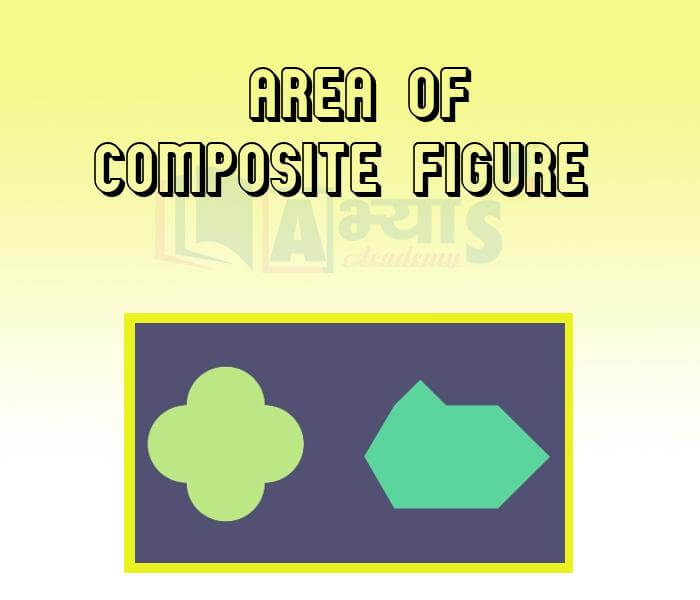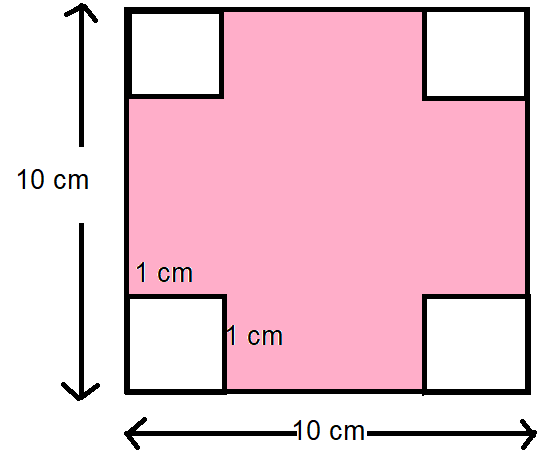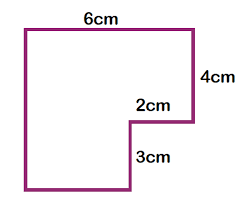Area of Composite Figure








Area of Composite Figure
A figure (or shape) that can be divided into more than one of the basic figures is said to be a composite figure (or shape). The area of a composite figure is calculated by dividing the composite figure into basic figures and then using the relevant area formula for each basic figure.
Illustration: Find the area of the following composite figure:
Solution: The figure can be divided into a rectangle and triangle as shown:




So, the area of the composite figure is
Illustration: Find the area of the shaded region.

Solution:
Given: Side of the outer square = 10 cm
Area of outer square = Side X Side
= 10 X 10
= 100 sq cm
Given: Side of the square which lies in the interior of above diagram = 1 cm
Area of the square which lies in the interior of the above diagram = Side X Side
= 1 X 1
= 4 sq cm
As 4 squares lie in the interior region, Hence the sum of the area of all the 4 squares = 4 + 4 + 4 + 4
= 16 sq cm
Now, area of shaded region = Area of the outer square - Area of 4 interior squares
= 100 - 4
= 96 sq cm
Illustration: A floor is 5 m long and 4 m wide. A square carpet of sides 3 m is laid on the floor. Find the area of the floor that is not carpeted.
Solution: Area of the rectangular floor = length X breadth
= 5 X 4
=
and the area of square carpet = side X side
= 3 X 3
=
The area of the floor that is not carpeted = Area of the rectangular floor - area of square carpet
= (20 - 9) sq m
=
50 hectare = ____________ sq m | |||
| Right Option : B | |||
| View Explanation | |||
The diagonals of a quadrilateral is 25 m in length and the perpendiculars to it from the opposite vertices are 8.4 m and 12 m . Find the area of the quadrilateral. | |||
| Right Option : A | |||
| View Explanation | |||
Find the area of the figure shown below
| |||
| Right Option : A | |||
| View Explanation | |||
Students / Parents Reviews [10]
Abhyas Methodology is very good. It is based on according to student and each child manages accordingly to its properly. Methodology has improved the abilities of students to shine them in future.

Manish Kumar
10thOne of the best institutes to develope a child interest in studies.Provides SST and English knowledge also unlike other institutes. Teachers are co operative and friendly online tests andPPT develope practical knowledge also.

Aman Kumar Shrivastava
10thAbhyas is a complete education Institute. Here extreme care is taken by teacher with the help of regular exam. Extra classes also conducted by the institute, if the student is weak.

Om Umang
10thMy experience was very good with Abhyas academy. I am studying here from 6th class and I am satisfied by its results in my life. I improved a lot here ahead of school syllabus.

Ayan Ghosh
8thMy experience with Abhyas is very good. I have learnt many things here like vedic maths and reasoning also. Teachers here first take our doubts and then there are assignments to verify our weak points.

Shivam Rana
7thA marvelous experience with Abhyas. I am glad to share that my ward has achieved more than enough at the Ambala ABHYAS centre. Years have passed on and more and more he has gained. May the centre flourish and develop day by day by the grace of God.

Archit Segal
7thI have spent a wonderful time in Abhyas academy. It has made my reasoning more apt, English more stronger and Maths an interesting subject for me. It has given me a habbit of self studying

Yatharthi Sharma
10thBeing a parent, I saw my daughter improvement in her studies by seeing a good result in all day to day compititive exam TMO, NSO, IEO etc and as well as studies. I have got a fruitful result from my daughter.

Prisha Gupta
8thIt was a good experience with Abhyas Academy. I even faced problems in starting but slowly and steadily overcomed. Especially reasoning classes helped me a lot.

Cheshta
10thIt was good as the experience because as we had come here we had been improved in a such envirnment created here.Extra is taught which is beneficial for future.

